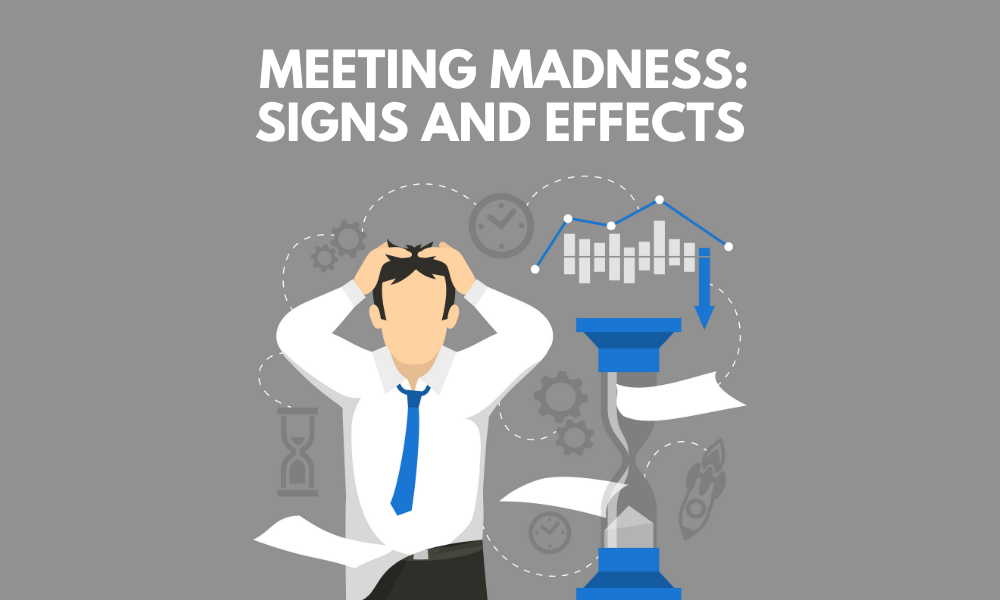
Meeting madness : Signs and Effects
Meetings are fundamental for the success of teams and organization and are the most frequently used management instrument. They provide employees with the opportunities to discuss their thoughts, ideas and concerns in a comfortable and collaborative environment, hence it becomes crucial to do them right. Despite the obvious importance they hold, they sometimes become a source of fatigue and frustration. This usually happens when meetings are unguided, consume too much time and hampers productivity.
Meeting madness is a mix of excessive and ineffective meetings with serious consequences.
The real culprits of ineffective meetings are multi-tasking and lack of engagement from participants. Unsurprisingly, engagement is crucial. Another blow to productive meetings, and often the culprit of boring, rambling ones, is lack of thoughtful meeting preparation. So rather than suffering through menial meetings, it makes more sense to revitalize them and deliver sessions that are both engaging and impactful.
Warning signs during your meetings and how to handle them
Diagnosing the extent to which your organization suffers from meeting madness is a key factor in driving change towards a more productive meeting culture. Unfortunately, individuals can’t drive this change on their own. Just think how many times you’ve tried to reduce the number of meetings on your calendar and were successful. Because so many people are involved in scheduling and running the meetings we attend, it takes a collective effort to fix them. With a structured approach to changing the meeting patterns throughout your team, you can escape the mad meetings’ trap and make significant improvements.
Here are some signs to diagnose the meeting madness and curb it -
- Your meetings ramble on without a clear purpose. If there’s an agenda, no one follows it
Good meeting practice says that a specific agenda will almost always reduce the time wasted in a meeting. Make it a practice to send out an agenda, review it at the beginning of the meeting and gain agreement to follow it. It’s also important to empower people to point out when the meeting veers off the agenda. This gives everyone a shared responsibility to keep things on track.
- People leave meetings tired, frustrated, angry or depressed.
Are your meetings longer than necessary or are they run without breaks? Consider the logistics of the meeting to see if your meetings actually help or hinder the work of the organization.
Foster a culture that respects everyone’s time. Declaring ‘meeting free’ slots could be one of the solutions as it also forces the whole group to reevaluate meetings that were normally scheduled during those slots. The additional ‘white space’ in everyone’s calendar increases individual productivity and reduces the spillover into personal time.
- People are distracted and doing their own thing - texting, talking on the phone, responding to email.
One way to avoid this is to establish ground rules that everyone agrees on before the meeting begins.
Clearly defined rules can help you set the right tone for your meetings and keep attendees from getting distracted. After all, even if your organization is a fun and upbeat place, your employees are still in a professional environment. Meeting rules can also help quell tensions when disagreements pop up. That’s important: Conflicts are somewhat inevitable when a bunch of people debate the best way forward. If you harness these conflicts to come up with great new ideas, meetings can instead be good learning opportunities. View our guide to setting some cardinal rules and making your virtual meetings a breeze.
- People show up unprepared. They haven’t read the report, document or spreadsheet that the meeting was about or they have not done the research they promised to do.
A well-run organization holds staff members accountable for doing their jobs and keeping their promises. But real life often falls short of how we know we should operate. Holding people accountable should be part of any set of ground rules for meetings. When you distribute the agenda in advance, state clearly the preparation that is expected of each member.
Meetings are places where people report on their work, share information, etc. When participants neglect to do what they promised, they are being insolent of others' time - the people who came to the meeting to partake and learn about the progress made. In addition to being discourteous to the fellow attendees, they are also making genuine monetary misuse of the organization’s assets.
- Meetings are dominated by a few talkers or there are people who never volunteer to speak up.
Facilitation can improve both the process and the outcome of meetings. Using a professional meeting facilitator or a chairperson is a promising solution to shooting up your meeting productivity. If that’s not an option, help the meeting leader develop some basic meeting facilitation skills that will even out participation.
To conclude, it is critical to regularly and openly take stock of how people feel about the meetings they attend and about their work process more informally. Frustration, resentment, and even hopelessness are signals that people are falling back into bad patterns. Changing protocols and behaviors takes time, and sustaining momentum requires consistent attention and contact. But once conquered, it results into a work environment which facilitates growth and learning for everyone involved.
Meeting Performance Effective Meetings